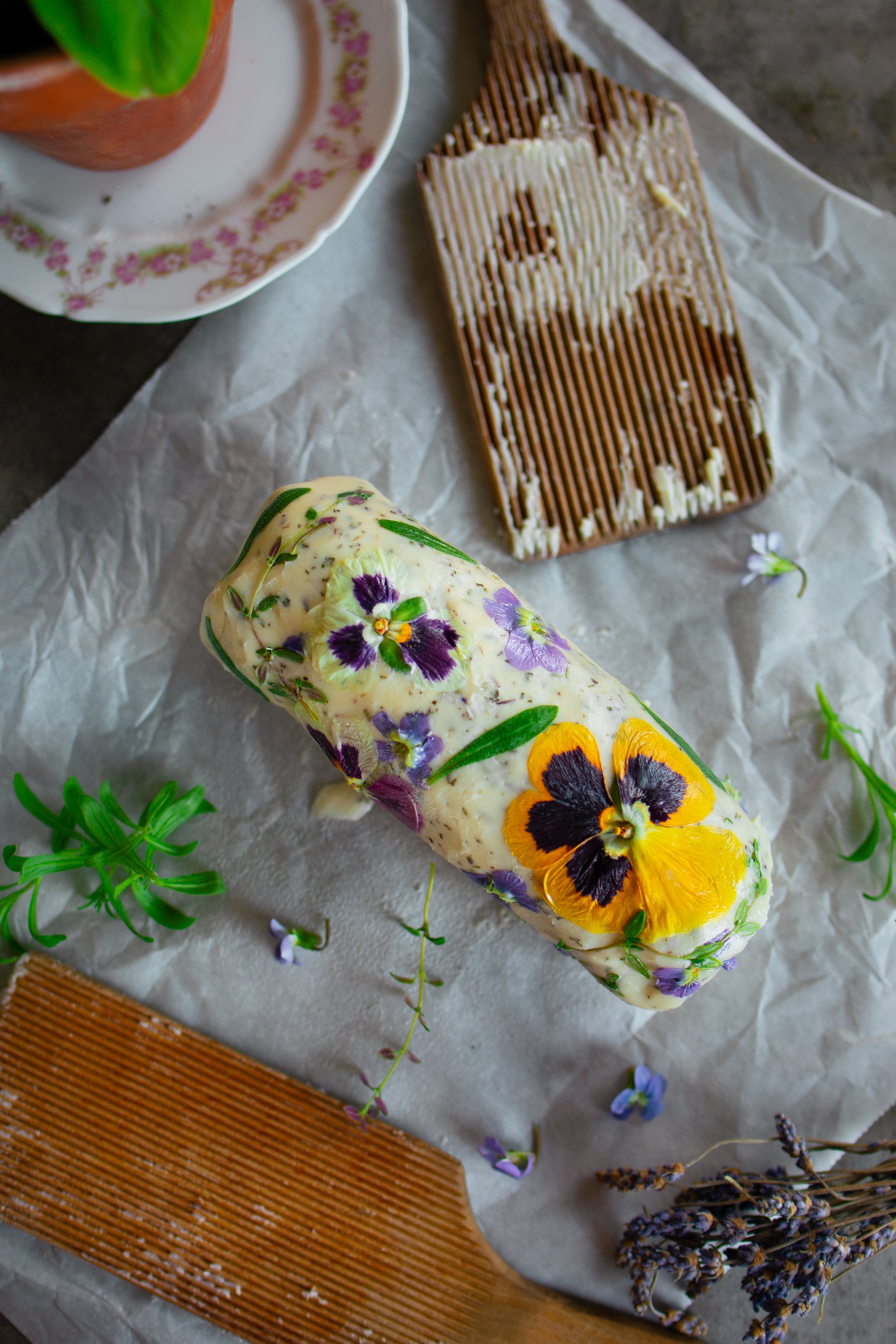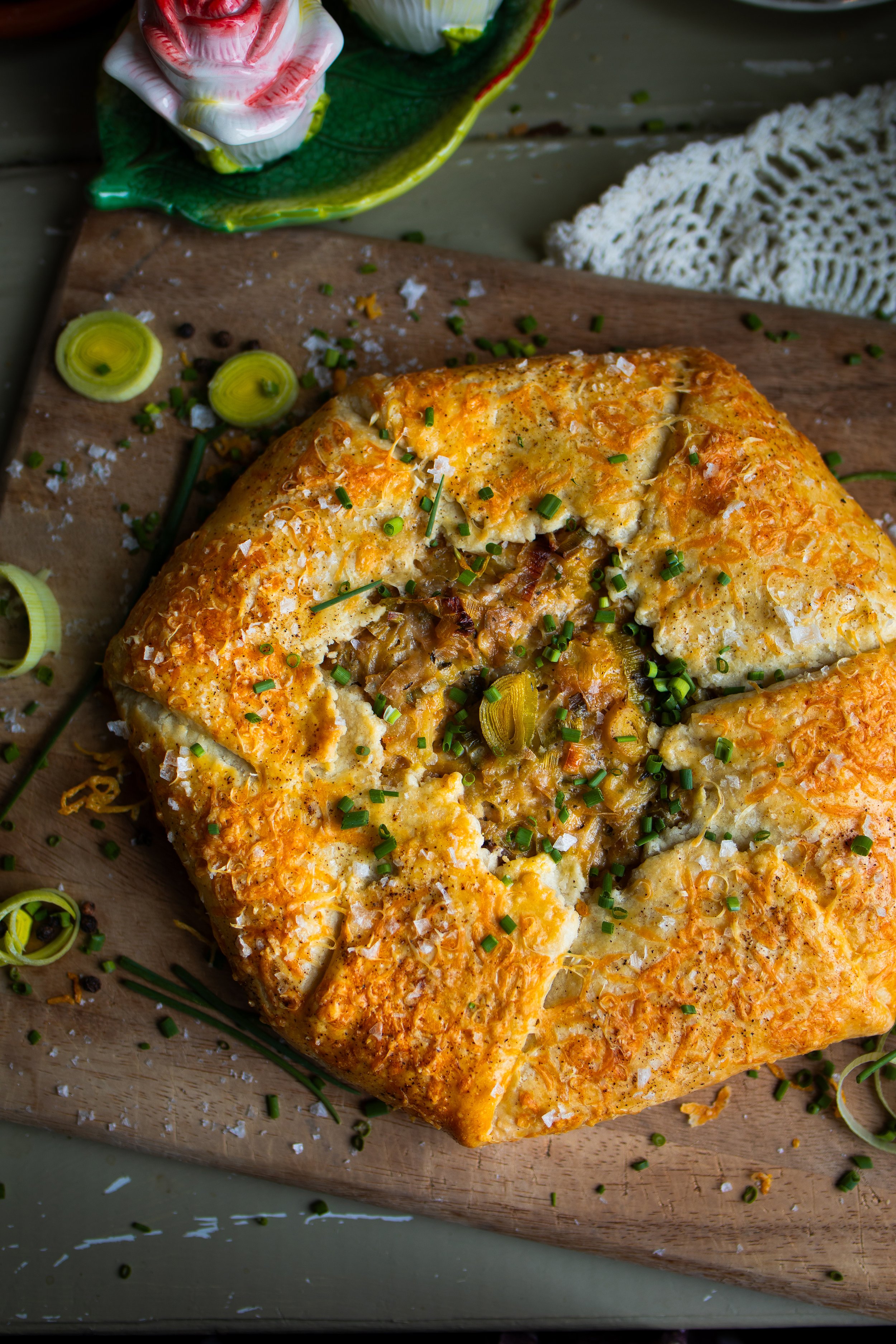Wild Violet and Lavender Herbal Compound Butter
This post may contain affiliate links, please see our privacy policy for more information.
Edible flowers are a wonderful way to incorporate whimsy and bright beautiful colors into your cooking. This recipe for herbal compound butter includes delightful the spring wildflowers wild violets, or Viola sororia, that you can find while out foraging. The addition of delicious herbs and lavender create a magical flavor palette that’s ideal for spring feasting. Enjoy this floral compound butter spread on toast, to roast meats, in soups and stews, or even as a topping for your pasta.
Of course, if wild violets are not available where you live, you can always substitute them with other edible flowers like lilacs, rose petals, pansies, or violas.
what is compound butter?
Compound butter is a French cooking technique where softened butter is creamed with additional ingredients such as herbs, garlic, vegetables, bone marrow, animal fat, citrus, honey, etc. Compound butter is an excellent cooking tool that adds a lot of flavor to a dish and saves you time in the kitchen. For instance, in a recipe where butter and garlic are needed, the combination is already made and ready to slice and use!
Enjoying the benefits of wild violets:
Edible flowers are one of my favorite ingredients to grow and forage when the weather becomes warm and sunny! There are so many delightful edible flowers that you can cook and bake with. For this recipe, I used wild violets, or Viola sororia (the common blue violet), but you can substitute any edible flower if wild violets are difficult to find where you live.
Here are some of the lovely benefits of wild violets and lavender:
Good for Your Health. They are anti-inflammatory, a good source of soluble fiber, cooling, help to moisten, a mild diuretic, and a mild laxative among other qualities.
Flowers and Leaves are Edible. The flowers and leaves of the wild violet are safe to eat and have been used throughout history for food and for medicine. Historically, it was used by Native American tribes as a cure for headaches and colds.
High in Vitamin A and C. If you are looking for an easy boost to your Vitamins A and C, try adding some wild violets into your diet! The leaves and petals can be eaten raw, cooked, or brewed into tea.
identifying wild violets:
Finding Wild Violets: Wild violets can be found in the eastern half of the United States, Canada, and in some parts of eastern Mexico. I have always loved them as a child, and I was always very conscious of them as I grew up in Illinois where they are the state flower. These flowers are invasive as they spread via rhizomes, or from spreading underground. However, they are protected in various places and for good reason: they are one of the first foods for native pollinators to forage on in the spring!
Basal Rosette: Violets are an herbaceous perennial with a basal rosette of heart-shaped leaves, or leaves that look like irregular lobes. They leaves have rounded teeth, though some are smooth.
Irregular Flowers: The flowers of violets can very, but they generally have bearded spurred petals. They will have a rounded tail, or nectar spur, connecting them to the stem. Some flowers are light purple, deep blue, and the Confederate violet (Viola sororia) is white with plue streaks. The inner throat of each flower is white with some dark veins radiating outwards towards the petals.
Blooming Period: Wild violets generally blooms from mid to late spring for about 1 to 1.5 months.
what is herbes de provence?
I started cooking with Herbes de Provence early in my cooking career have used it ever since. The blend comes from the Provence region in the south of France. It became popularized by Julia Child in one of her recipes, Poulet Sauté aux Herbes de Provence, or chicken in an herbal white wine sauce. The addition of lavender is an American tradition, which I assume has to do with the French being known for their gorgeous lavender fields. I think it is a beautiful mix for most meals, especially as a rub for roasted meats.
Generally, Herbes de Provence is made with a blend of marjoram, rosemary, thyme, basil, oregano, savory, and bay leaves. Lavender is an American addition to this blend and is typically not added to true French versions of Herbes de Provence.
gathering ingredients to make compound butter:
Before you begin making your Herbes de Provence Compound Butter, you will need to gather a few key ingredients. This delicious French blend of aromatic herbs can introduce you to many new herbs that you may not have tried cooking with before, elevating the flavors of your meals!
Butter. For this recipe, you will wanted to a use a salted butter. If you decide to use unsalted butter, you can add salt to the butter mixture to your taste.
Wild Violets. If you cannot forage or find wild violets, you can simply omit them or use another edible flower in its place like cultivated violas or pansies.
Lavender. Did you know that lavender is actually not part of French blends of Herbes de Provence? It’s an American addition.
Thyme. If you cannot find fresh thyme, dried thyme leaves can be used instead. I would suggest lessening the amount of herbs to about half of the suggested amount if you are using dried herbs.
Basil. Fresh basil gives this compound butter a sweet and lovely flavor. I recommend using a Genovese variety and staying away from Thai or Lemon Basil.
Rosemary. Rosemary brings a lovely scent and flavor.
Marjoram. If marjoram is difficult to find, you can replace it with more oregano.
Savory. You can use summer or winter savory, whichever you prefer!
Pansies. The pansies are purely for decorating this delightful butter! Any edible flowers can be used.
how to use compound butter:
This Herbes de Provence Compound Butter is so beautiful you almost do not want to slice into it! But once you do, it will make a perfect addition to your meal. Here are some ideas for how to use your compound butter:
Spread It. Spread this floral flavored compound butter on toast, muffins, fresh bread, scones, biscuits, and more.
Melt It. If you enjoy cooking meat over the stove, this butter is an excellent ingredient to pair with steak, chicken, fish, or vegetables.
Stir It. Looking for a flavor boost for your pasta or rice? Stir this delightful herbal blend into your next warm pot of fettucine!
Roast It. Before your roast your next chicken or beef roast, rub it down with some of your compound butter. Don’t forget to rub under the skin for even more flavor!
final thoughts:
This Wild Violet and Lavender Herbal Compound Butter is exceptionally easy to make. I love how absolutely beautiful it looks covered in fresh green herbs and bright purple pansies. If you love beautifully presented foods that have a variety of uses in your cooking, you will be bound to love this whimsical compound butter recipe. Enjoy!
xoxo Kayla
My dress is the Edwina 22 from Linennaive (gifted).

Wild Violet and Lavender Herbal Compound Butter
Ingredients
- 1 1/2 cups (174 g) salted butter, softened
- 2 tbsp (4 g) fresh thyme
- 2 tbsp (3 g) fresh basil, chopped
- 2 tbsp (3 g) fresh rosemary, chopped
- 2 tbsp (8 g) fresh oregano, chopped
- 2 tbsp (8 g) fresh marjoram, chopped
- 2 tbsp (6 g) fresh savory, chopped
- 2 tbsp (4 g) fresh fennel leaf, chopped
- 2 tbsp (4 g) fresh bay leaves, chopped
- 2 tbsp (6 g) fresh wild violet petals, separated
- 1 tbsp (3 g) fresh or dried lavender buds
- 6 to 8 fresh pansies, whole
Instructions
- In a large bowl, cream the butter with a wooden spoon so that is is no longer firm and blocky, about 2 to 3 minutes.
- With a wooden spoon or spatula, mix in the thyme, basil, rosemary, oregano, marjoram, savory, fennel leaves, bay leaves, wild violets, and lavender buds until they are well incorporated and distributed evenly throughout.
- Transfer the butter to a piece of wax paper. With your hands, shape the butter into a cylinder. Roll the butter around on the wax paper until a desired shape is formed. With your fingers, place the pansies and any extra pieces of herbs on the butter in any design that you like.
- Cover the compound butter in plastic wrap and refrigerate until solidified again, about 1 to 2 hours.
- Unwrap the butter and slice it into 1-inch (2.5-cm) thick slices, if desired. You can use this butter to top bread, as a rub on meat for roasting or grilling, or any way that you like! Store any unused butter in the refrigerator, wrapped, for about one week. Compound butter can also be frozen for about 6 months.
Nutrition Facts
Calories
318Nutritional information is only an estimate. The accuracy of the nutritional information for any recipe on this site is not guaranteed.













